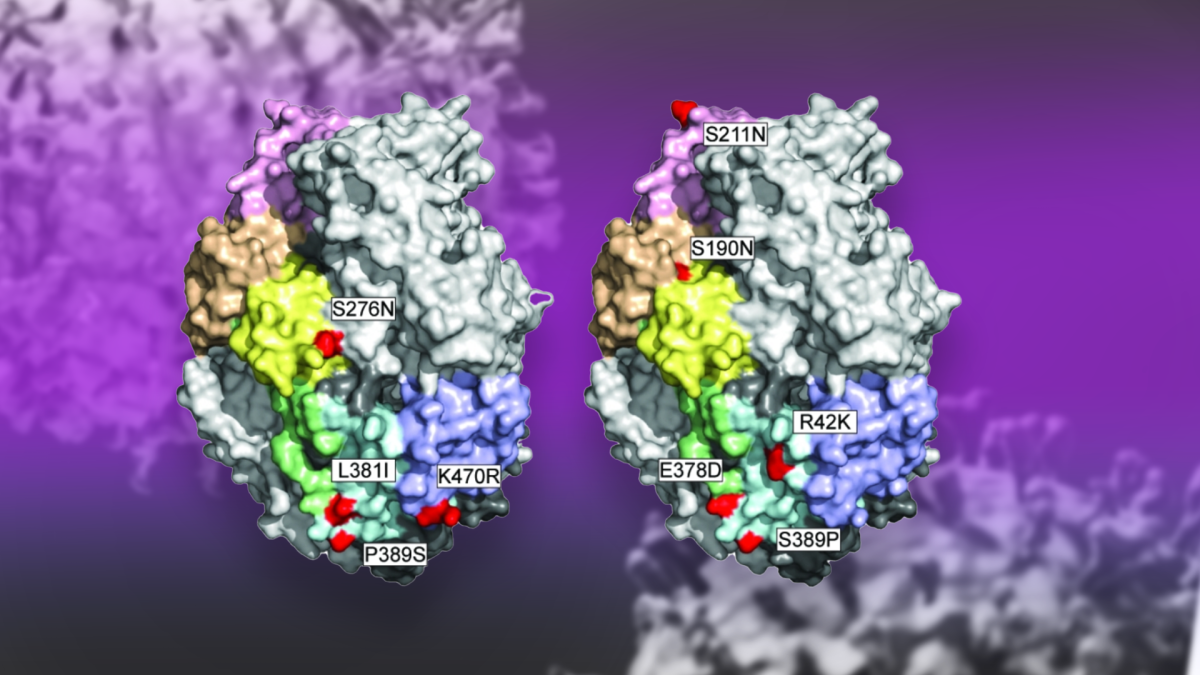Decoding RSV: Study explores viral mutations with implications for vaccine effectiveness

A new study explores mutations appearing in crucial regions of RSV. These alterations may help enable RSV to evade vaccines designed to target it. Graphic by Jason Drees
Between November 2022 and April 2023, three viral diseases surged in Arizona and across the United States: influenza, COVID-19 and Respiratory Syncytial Virus (RSV). This simultaneous spread, described as a "tripledemic," led to widespread sickness and challenged public health response efforts.
In a comprehensive, first-of-its-kind study, Arizona State University researcher Efrem Lim and his colleagues identify mutations in key areas of RSV, which the pathogen may have developed in an effort to evade targeting by vaccines designed to eradicate it. This was accomplished by analyzing viral genomic sequences from patient samples collected in Arizona during the 2022–23 RSV season.
The new research highlights RSV mutations that may allow the pathogen to sidestep therapeutic protection by altering a specific viral region targeted by RSV vaccines.
RSV is a major cause of acute respiratory infections, particularly in children, adults with severe lung conditions and the elderly. Lab-confirmed cases of RSV in Arizona increased significantly during the study period, peaking in mid-November of last year.
The innovative study underscores the need for ongoing genomic surveillance to ensure vaccine effectiveness. Adaptations in vaccine formulations may be necessary to cope with the virus's evolving landscape.
The research is particularly noteworthy as it is the first study of contemporaneous RSV strains displaying mutations that may impact the FDA-approved RSV vaccines.
“There was no information about what mutations are showing up in RSV strains circulating in communities. How do we protect people if we don’t know what we’re going up against?” said Lim, the study’s senior author. “Surveillance provides a basis to always have the right vaccines at hand.”
Lim is a researcher with the Biodesign Center for Fundamental and Applied Microbiomics. He is also an associate professor with the School of Life Sciences at ASU.
The new research appears in the journal Emerging Infectious Diseases.
According to the Centers for Disease Control, the Respiratory Syncytial Virus typically results in symptoms akin to a mild cold for most individuals. While the majority recover within one to two weeks, the virus can pose serious risks. Infants and senior citizens in particular are more susceptible to severe forms of RSV that may require hospitalization.
For older adults, vaccines have been developed to mitigate the risk of severe RSV. Additionally, monoclonal antibody treatments are available to safeguard infants and young children from more severe outcomes of the virus.
RSV cases surged much earlier than expected during the 2022–23 respiratory virus season, coinciding with high levels of flu and COVID-19. These developments prompted a study to investigate the genetics behind this uncharacteristic early spike.
Sequencing the RSV genome
The researchers sequenced cases from the Arizona "tripledemic" season. The samples were taken from nasopharyngeal swabs acquired during respiratory testing. Next-generation genomic sequencing was performed on 127 samples, with a median patient age of 22 years.
The genetic codes revealed changes in important parts of a key viral protein. These changes were found in both main subtypes of RSV. The study sequenced the complete genomes of both 92 RSV-A and 24 RSV-B samples, along with partial genomes of 11 additional specimens. The sequencing results enabled tracking of new mutations in the RSV genome over time.
A method known as phylogenetic analysis can be used to determine how different species or organisms, like viruses or bacteria, are related to each other based on their genetic makeup.
Knowing how a pathogen has changed or moved can help researchers figure out where an outbreak started, how it's spreading and what kinds of treatments might work best.
In the new study, phylogenetic analysis showed RSV-A had multiple separate introductions into Arizona. In contrast, RSV-B originated from a single introduction that seeded local transmission.
The researchers identified mutations in major antigenic sites of the RSV fusion (F) protein, which forms the basis for two RSV vaccines (GSK’s Arexvy and Pfizer’s Abrysvo) recently approved by the FDA for individuals 60 years and older and pregnant individuals, to protect their newborns. Altered portions found on the outer surface of this crucial viral protein suggest that RSV may be tinkering with its genome in an effort to outwit RSV vaccines.
Ongoing surveillance critical
The study demonstrates the value of sequencing RSV genomes over time to detect genetic changes relevant for vaccine design. The mutations identified in RSV F protein antigenic sites emphasize the importance of tracking viral evolution to improve vaccine formulations.
As RSV remains a substantial clinical burden, particularly for infants and older adults, optimizing RSV vaccines through genomic insights will be key. This Arizona-based study highlights the value of state-level viral genomic sequencing to inform national and global mitigation strategies. The techniques are applicable not only to RSV, but to a broad range of infectious agents posing a threat to public health.
“We are taking a modernized approach to meet the needs of medical health care and public health,” Lim said.
More Science and technology

ASU professor wins NIH Director’s New Innovator Award for research linking gene function to brain structure
Life experiences alter us in many ways, including how we act and our mental and physical health. What we go through can even…

ASU postdoctoral researcher leads initiative to support graduate student mental health
Olivia Davis had firsthand experience with anxiety and OCD before she entered grad school. Then, during the pandemic and as a…

ASU graduate student researching interplay between family dynamics, ADHD
The symptoms of attention deficit hyperactivity disorder (ADHD) — which include daydreaming, making careless mistakes or taking…
